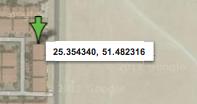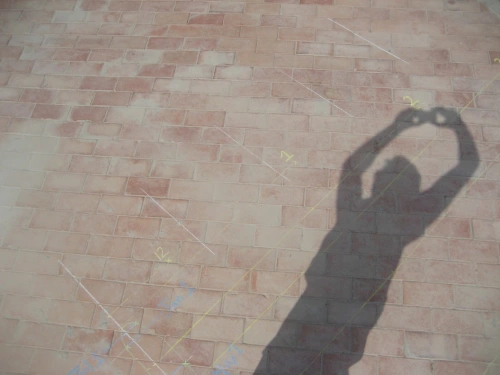Last year I was lucky enough to receive a grant to build an outdoor classroom at my school, so throughout the school year I’ll be brainstorming ways to make the most of this new learning space. Living in the hot and urban environment of Doha, Qatar, my students don’t have much experience with the outdoors, so I think there’s going to be a ton of opportunities for learning across many different disciplines.

One outdoor classroom project that I’m working on right now is the Human Sundial. It’s similar to the boring old sundials you’re probably familiar with, except that it’s your shadow, and not some little stick’s, that points towards the correct time. Another cool feature of this type of sundial is that it corrects for the change in shadows over the course of the year. For those interested in details, this kind of sundial is technically known as a analemmatic sundial; the analemma is the name of the shape created by the apparent movement of the sun’s location in the sky over the course of the year.
In this post I’ll explain the nuts and bolts of how to make one of these yourself (it’s not hard- I just did it this afternoon!), but first I want to share some ideas for how I’m going to use this as a teacher in (whoops- I mean outside of) the classrom.
Teaching with the sundial
Any time a teacher has a cool tool like the human sundial, there’s the danger that you assume students will just somehow “get it” when you show it off in some classroom demonstration. Even if the demo has a wow-factor, more often than not students will leave remembering the phenomenon, but not the un-wowing explanation that follows it. So how to prevent this?
First of all, I’m not going to show the students the sundial right away. That would be like starting a mystery movie by revealing the culprit in the first scene- boring! First I want students to discover how tricky telling time with the sun actually is. With my kindergarten students, who are mostly focusing on shadows, we could begin by just tracking the shadow of a stationary object (like a flag pole) throughout the day. Maybe have a student mark the end of the shadow every hour, or if we wanted to get hi-tech we could try a time-lapse video. If we have a few classes do this and compare the data, I think the students will readily realize that shadows point in certain directions and have certain lengths at different times of the day. I could then up the ante for comprehension by having a shadow prediction contest (where will this flagpole’s shadow be at 3:30?). The Kgers could then even make their own simple sundial using chalk like I did, and record videos of themselves explaining how it works (assessment, baby!).
For my 5th graders, who also have an astronomy unit and learn about the rotation and revolution of the Earth, I’d like them to learn about the whole analemma effect- how then sun’s apparent location and shadows change over the course of the year. It’s safe to assume they won’t have many prior conceptions about this, and probably think the sun’s path in the sky is relatively constant- so I can exploit that misconception for my own devious learning intentions! I plan on installing the human sundial in the outdoor classroom- but without the analemma date thing to stand on. I’ll just mark the spot that works in September so the students will be none the wiser when they check it out at the beginning of the year. As time marches on though, the sundial will get worse and worse at time-keeping, and by January it should be downright awful. This would be a great time to raise the alarm and have the student’s try to figure out what’s going on. To juice this for all it’s worth I’ll need to make sure there are some grade-level appropriate resources out there that they can use though (any help here would be much appreciated). Then I can use their suggestions and introduce the analemma to fix the sundial…. until next year of course!
Setting up the sundial
I’m no sundial guru, so initially I tried to order up plans for a human sundial from here. Unfortunately, because Qatar’s latitude of 25 degrees North is nearly in the tropics the owner actually refused to sell me the plans, even after repeated requests, because he was worried the sundial’s accuracy and somehow his company’s reputation would be compromised. Whatever. While it’s true that in the tropics shadows aren’t very long in the summer at high noon, we won’t be using our sundial in the summer, and I don’t think Kindergarteners will be too concerned with pinpoint accuracy. At any rate- you definitely don’t need to go out and spend money on plans for a human sundial, because there are plenty of free resources just a click away. So let’s get started…

- First you need your exact latitude and longitude. You can use a GPS for this, or you can just go to Google Maps, find your location, and then right-click on it and select “What’s here?”. This will place a little green arrow on your location that you can hover over and get the latitude and longitude. It leaves it up to you to figure out if you’re North or South of the equator and East or West of the prime meridian (good luck with that!).
- You also need to know your time zone (how many hours plus or minus Greenwich mean time), and whether you’re currently having daylight savings time. Since Qatar doesn’t bother with daylight savings, this doesn’t affect me, but it will require some alterations to your sundial if you are in a place that does.
- Make sure your sundial location is level. You could use one of those bubble-in-liquid carpenter-thingies to do this, or you could do what I did… take a look at your space and say “Looks pretty level to me!”.
- Then you need to find true North. No, you can’t use a compass because they point towards magnetic North. There’s a variety of ways to figure out true North, but I think the easiest method is using Solar Noon (when the sun is at its highest point on the horizon), because all you need are some household supplies to make a straight shadow at the time of Solar Noon. Here’s a good explanation of how to do it. Don’t feel like you need to go get all the construction materials though- I hung my weight off an overhead car shade and just traced the shadow with chalk on the pavement.
- Once you have a true North/South line set up, then you can start setting up the sundial. To get an idea of what the finished product will look like, I recommend checking out the applet on this website which draws the analemmatic sundial for you when you input the above info (see picture below). You can actually print this out and use it as a mini-sundial as well, just make sure to line it up with your true North/South line.

- So far so good? Now on to the human-sized sundial! The math for creating one of this sundials is pretty complicated, so to avoid crunching the numbers yourself, you can use a spreadsheet like this. This spreadsheet might seem a little daunting at first, but the only info you need to input is the cells in blue on the first sheet. Besides the info above you’ll also need to find out your time zone meridian which is the middle longitude for your time zone (you can find this on the picture here, just look at the longitude number above your time zone- for example Qatar’s time zone is +3 so the meridian is 45 degrees East). Finally you need to input the gnomon height, which is simply the height of the thing casting the shadow- you!
When the spreadsheet spits out your numbers, just check the pictured sundial on the sheet called “Layout” and make sure it’s identical to the mini-sundial made by the applet. If it is, you’re ready to start building the real sundial. Start by creating an origin point (like 0,0 on a graph) somewhere in the middle of your true North/South line. Then it’s just like making a giant graph- use the x and y coordinates to plot the hour markers, and the x and “date point Z” coordinates to plot the dates. I did mine in chalk first on the pavement to check if it actually works.
For more information on how you can use a human sundial for some great learning activities, check out my follow-up post here.

